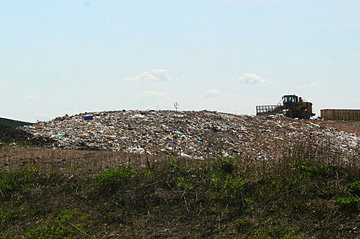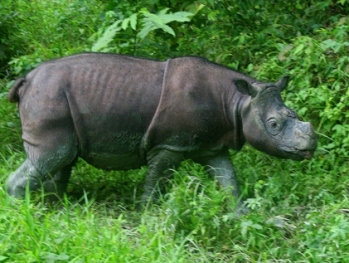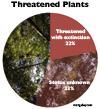Too many people consuming too much is depleting the world’s natural resources faster than they are replenished, imperiling not only the world’s species but risking the well-being of human societies, according to a new massive study by the World Wildlife Fund (WWF), entitled the Living Planet Report. The report finds that humanity is currently consuming the equivalent of 1.5 planet Earths every year for its activities. This overconsumption has caused biodiversity—in this case, representative populations of vertebrate animals—to fall by 30 percent worldwide since 1970. The situation is more dire in tropical regions where terrestrial species’ populations have fallen by 60 percent and freshwater species by 70 percent.
Produced in collaboration with the Zoological Society of London (ZSL) and the Global Footprint Network the biannual report follows the health of nearly 8,000 animal populations across 2,500 representative species. For example, the white-rumped vulture’s population has collapsed by 50 percent from 2000-2007, while leatherback marine turtles’ population has dropped by 20 percent from 1989-2002. The report finds that there are five major causes for such species’ population crashes: habitat loss, over-exploitation, pollution, invasive species, and climate change. All of these threats are linked to human consumption patterns.
“[Human consumption] demands are largely met by a few key sectors: agriculture, forestry, fisheries, mining, industry, water and energy. Together, these sectors form the indirect drivers of biodiversity loss,” the report explains. “The scale of their impact on biodiversity depends on three factors: the total number of consumers, or population; the amount each person is consuming; and the efficiency with which natural resources [used].”
 Landfill in Minnesota, US. Photo by: Jeremy Hance |
The tropics are the most threatened region. Industrial agriculture, livestock, mining, oil and gas, and infrastructure such as roads have led to large-scale and on-going deforestation in tropics, where the majority of the world’s biodiversity lives.
“The decline of tropical forests is well-reflected in population trends of individual species like tigers, elephants and rhinos, which need these habitats to survive. In Riau province on the island of Sumatra, we have lost 65 percent of forest cover in 25 years and as a result, tiger populations have decreased by about 70 percent and elephants by 84 percent,” says Dr. Sybille Klenzendorf, Managing Director of WWF’s Species Conservation Program in a press release. “What we need to realize is that the consumption of vital commodities that are harvested in these areas, such as paper and oil palm […] are devastating important habitats and destabilizing our climate. It is time we look at more sustainable ways of living and sourcing commodities to save ourselves, our children, and the species we care about.”
As Klenzendorf point out the loss of natural ecosystems isn’t just impacting tigers, rhinos, and elephants. Services from nature that humanity depends on, known as ‘ecosystem services’, are being degraded and lost due to the expanding human footprint. Such ecosystems services include freshwater availability, pollination, climate stability, food production, erosion and flood control, and future medicines. While humans are dependent on water for survival, the report’s Water Footprint of Production finds that 71 nations are seeing stress on their non-renewable water sources, a trend that’s expected to grow worse as the climate continues to warm.
As expected some regions consume more than others. For example, if everyone on Earth consumed as much as the average American, global society would need 4.5 Earths to achieve sustainability instead of 1.5.
“Rich nations must find ways to live much more lightly on the Earth—to sharply reduce their footprint, including in particular their reliance on fossil fuels. The rapidly-growing emerging economies must also find a new model for growth—one that allows them to continue to improve the wellbeing of their citizens in ways that the Earth can actually sustain,” James P. Leape, Director General of WWF International, writes in the report.
 A Sumatran rhino in captivity in Borneo. The Sumatran rhino is on the edge of extinction with only 200 individuals estimated to survive. Photo by: Jeremy Hance. |
One bright spot is that species populations in the temperate regions, as opposed to tropical, are on the rise as a whole. However, the report points out that this is largely due to when the first Living Planet analysis was undertaken in 1970.
“If the temperate index were to extend back centuries rather than decades it would very probably show a long-term decline at least as great as that shown by tropical ecosystems in recent times,” the authors write. However, according to the report, conservation efforts, forest re-growth, and improvements in pollution have clearly aided temperate species in the near-term.
Overall, humanity’s ecological footprint has doubled since 1966 and likely surpassed the Earth’s capacity sometime in the 1970s. Much of the ballooning footprint is linked to greenhouse gas emission, which have grown by 35 percent since 1998. According to the report, humanity needs to drastically change the way it consumes natural resources or environmental problems—and the economies that they underpin—will only worsen.
“Under a ‘business as usual’ scenario, the outlook is serious: even with modest UN projections for population growth, consumption and climate change, by 2030 humanity will need the capacity of two Earths to absorb CO2 waste and keep up with natural resource consumption,” the report reads.
By the time the global population is expected to stabilize at around 9 billion people in 2050, 2.8 Earths will be necessary if ‘business as usual’ continues.
To avoid this fate and achieve true sustainability, the report makes a number of recommendations, for example: measure human well-being as more than just GDP; protect 15 percent of the world’s land and marine regions; enhance land productivity; employ a new economic system for valuing ecosystems and biodiversity; eliminate perverse subsidies; and build a green energy economy, rapidly phasing out the need for fossil fuels, among others.
“Sustainability should not be an option for consumers. Consumers should have only good choices. The science is clear: current ways of doing business undermine the competitiveness of companies and, ultimately, the life support systems of the planet. As such, they threaten companies’ ability to continue producing products,” says Dr. Jason Clay, WWF Senior Vice President, Market Transformation.
Related articles
Losing nature’s medicine cabinet

(10/04/2010) In all the discussions of saving the world’s biodiversity from extinction, one point is often and surprisingly forgotten: the importance of the world’s species in providing humankind with a multitude of life-saving medicines so far, as well as the certainty that more vital medications are out there if only we save the unheralded animals and plants that contain cures unknown. Already, species have provided humankind everything from quinine to aspirin, from morphine to numerous cancer and HIV-fighting drugs. “As the ethnobotanist Dr. Mark Plotkin commented, the history of medicine can be written in terms of its reliance on and utilization of natural products,” physician Christopher Herndon told mongabay.com. Herndon is co-author of a recent paper in the journal Biotropica, which calls for policy-makers and the public to recognize how biodiversity underpins not only ecosystems, but medicine.
Rivers worldwide in peril: society treats symptoms, ignores causes

(09/29/2010) Dams, agricultural runoff, pesticides, sewage, mercury pollution from coal plants, invasive species, overconsumption, irrigation, erosion from deforestation, wetland destruction, overfishing, aquaculture: it’s clear that the world’s rivers are facing a barrage of unprecedented impacts from humans, but just how bad is the situation? A new global analysis of the world’s rivers is not comforting: the comprehensive report, published in Nature, finds that our waterways are in a deep crisis which bridges the gap between developing nations and the wealthy west. According to the study, while societies spend billions treating the symptoms of widespread river degradation, they are still failing to address the causes, imperiling both human populations and freshwater biodiversity.
Conserving nature with economics

(09/29/2010) While many factors come into consideration when the fate of forests are being determined, economics often play a key role in land use decisions. When the perceived value of forest land is higher as cattle pasture, cropland, or plantation, then trees fall. But what happens when economic assumptions underlying these decisions are wrong? Forests, including the services they provide and the biodiversity they shelter, are lost in vain, much to the detriment of society and the planet. Working to avoid these costly outcomes is the Conservation Strategy Fund (CSF), a California-based nonprofit that trains conservationists to use economics and strategic thinking as assets to conserve natural ecosystems in countries around the globe. CSF runs training programs that help emerging conservation leaders build and strengthen parks, influence policies, and avert damage from infrastructure projects.
Mass extinction fears widen: 22 percent of world’s plants endangered

(09/28/2010) Scientific warnings that the world is in the midst of a mass extinction were bolstered today by the release of a new study that shows just over a fifth of the world’s known plants are threatened with extinction—levels comparable to the Earth’s mammals and greater than birds. Conducted by the Royal Botanic Gardens, Kew; the Natural History Museum, London; and the International Union for the Conservation of Nature (IUCN), the study is the first time researchers have outlined the full threat level to the world’s plant species. In order to estimate overall threat levels, researchers created a Sampled Red List Index for Plants, analyzing 7,000 representative species, including both common and rare plants.
Nearly half of the world’s wetlands used for crops
(09/27/2010) Wetlands used for crops have expanded significantly over the past eighty years. According to a new study in the open-access journal Tropical Conservation Science, wetlands being utilized for crop production has jumped from 25 percent in 1926 to 43 percent in 2006 of the world’s wetlands as identified by the Ramsar Convention on Wetlands.
Why biodiversity is worth saving
(09/23/2010) In recognition of the United Nations’ declaration of 2010 as the ‘International Year of Biodiversity’, the Association for Tropical Biology and Conservation (ATBC) has included a special section on the biodiversity in its September 2010 issue of Biotropica.
Nation’s wealth does not guarantee green practices

(08/11/2010) Developing countries are not the only ones that could benefit from a little environmental support. Wealthier countries may need to ‘know themselves’ and address these issues at home too. According to a recent study in the open access journal PLoS ONE, wealth may be the most important factor determining a country’s environmental impact. The team had originally planned to study “country-level environmental performance and human health issues,” lead author Corey Bradshaw, Director of Ecological Modeling and professor at the University of Adelaide, told mongabay.com. Once they began looking at the available indexes, however, they saw the need for a purely environmental analysis.